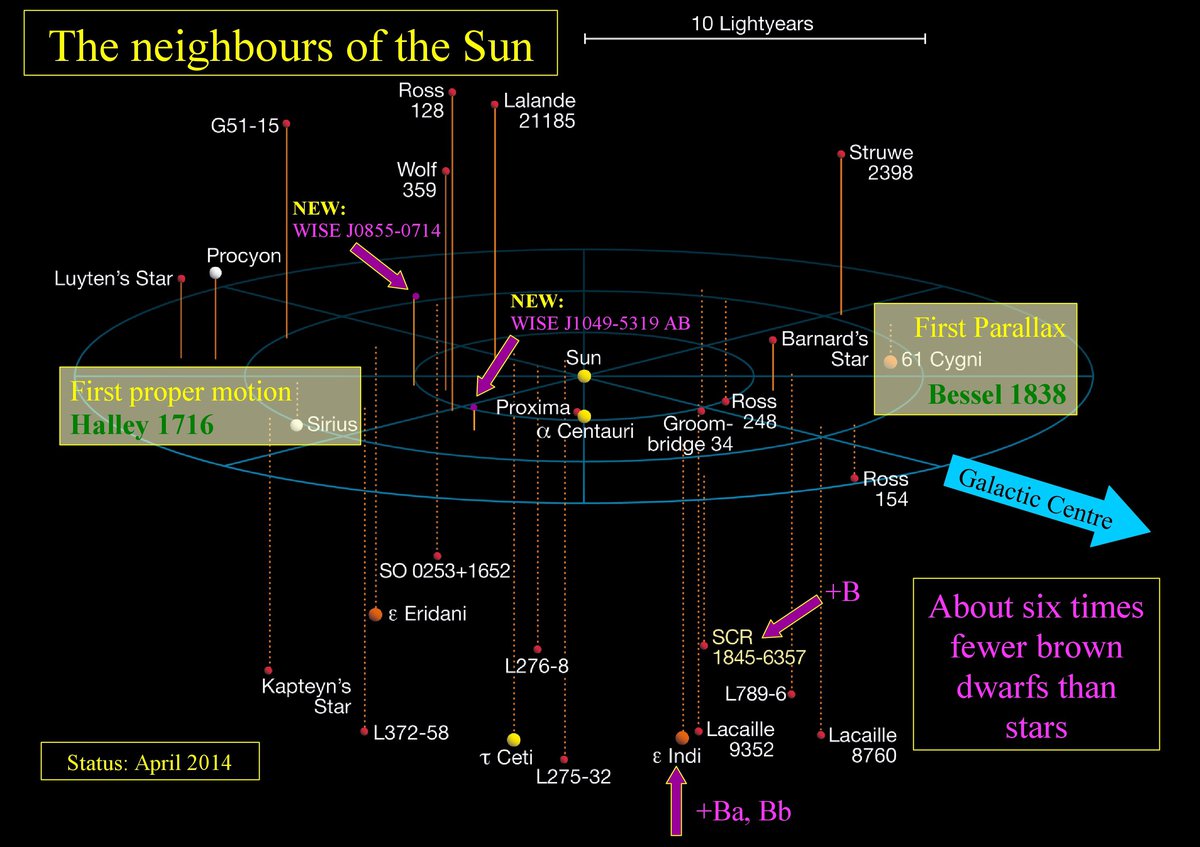* Illustrations

3D-map of the Solar neighbourhood (status: April 2014):
Up to a distance of about 12.5 light years, all known stars (white: Sirius and Procyon, yellow: the Sun and other G dwarfs, orange: K dwarfs, red: M dwarfs) and brown dwarfs (magenta) are shown. Most of the red dwarf stars (M dwarfs) have been discovered since about 100 years ago with the application of astro-photography, whereas the brown dwarfs have only been detected after the year 2000 with help of infrared observations.

The closest Solar neighbours (status Febuary 2015):
Our neighbours are shown up to a distance of about 21 light years (x-axis) and sorted by their spectral types and corresponding surface temperatures (y-axis). The white dwarfs (WD) form a top row (white dots), followed by three A- and F-type stars (cyan crosses), the solar-type G and K dwarfs (yellow), the M dwarfs (red), constituting about 3/4 of all stars, and the brown dwarfs (magenta) of spectral types L, T, and Y at the bottom. Green open symbols mark those objects discovered at the AIP in Potsdam. A dividing line between stars and brown dwarfs is shown here at a temperaure of about 2000K, but an exact separation between these object classes is determined by the limiting mass (not shown here) of about 8% of a solar mass.
Credit: Ralf-Dieter Scholz, AIP
The closest Solar neighbours (status Febuary 2015), print version:
Our neighbours are shown up to a distance of about 21 light years (x-axis) and sorted by their spectral types and corresponding surface temperatures (y-axis). The white dwarfs (WD) form a top row (white dots), followed by three A- and F-type stars (white crosses), the solar-type G and K dwarfs (yellow), the M dwarfs (red), constituting about 3/4 of all stars, and the brown dwarfs (black) of spectral types L, T, and Y at the bottom. Blue open symbols mark those objects discovered at the AIP in Potsdam. A dividing line between stars and brown dwarfs is shown here at a temperaure of about 2000K, but an exact separation between these object classes is determined by the limiting mass (not shown here) of about 8% of a solar mass.
Credit: Ralf-Dieter Scholz, AIP
Stellar and substellar fractions in the Solar neighbourhood:
The by far largest stellar fraction consists of red (M) dwarfs (shown in red). Solar-type (G and K) dwarfs (yellow), white dwarfs (white), and Sirius-like (A and F) dwarfs (cyan) represent smaller stellar fractions. The substellar fraction of brown dwarfs (magenta), with spectral types L, T, and Y, is still growing and has already outnumbered the fraction of Solar-type stars.
Credit: Ralf-Dieter Scholz, AIP
Successful Search for new neighbours of the Sun:
Compared to our knowledge in the year 2000 (blue histogram), the numbers of newly discovered neighbours within 10 pc from the Sun (in green) is shown for different spectral types. Whereas a small increase can be seen for white dwarfs (WD), large numbers of red dwarf stars (M) and brown dwarfs (LTY) could be detected in our neighbourhood. This illustration is based on data from RECONS (status: March 2018).
Credit: Ralf-Dieter Scholz, AIP